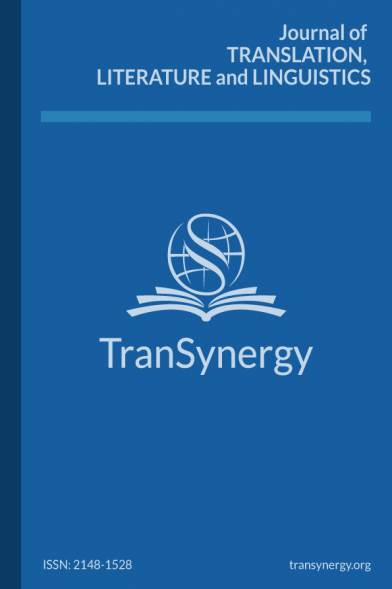The Impact of In-house Guidelines on Subtitle Quality: A Sample Study of TED Translators in the FAR Model
Keywords: subtitling, in-house guidelines, subtitle quality, crowdsourcing, the FAR Model
The Impact of In-house Guidelines on Subtitle Quality: A Sample Study of TED Translators in the FAR Model
Keywords: subtitling, in-house guidelines, subtitle quality, crowdsourcing, the FAR Model,
___
References
Béhar, H. (2004). Cultural ventriloquism. In A. Egoyan & I. Balfour (Eds.), Subtitles: On the
foreignness of film (pp. 79–86). The MIT Press and Alphabet City Media.
Bogucki, Ł. (2016). Areas and methods of audiovisual translation research. Peter Lang
Edition.
Bogucki, Ł. (2020). A relevance-theoretic approach to decision-making in subtitling. Palgrave
Macmillan.
De Linde, Z., & Kay, N. (2014). The semiotics of subtitling. Routledge.
Díaz-Cintas, J. (2003). Teoría y práctica de la subtitulación inglés/español. Editorial Ariel.
Díaz-Cintas, J., & Remael, A. (2021). Subtitling: Concepts and practices. Routledge.
Gottlieb, H. (1997). Subtitles, translation & idioms. Center for Translation Studies.
Gottlieb, H. (2004). Language-political implications of subtitling. In P. Orero (Ed.), Topics in
audiovisual translation (pp. 83–100). John Benjamins Publishing Company.
https://doi.org/10.1075/btl.56.11got
Gottlieb, H. (2009). Subtitling against the current: Danish concepts, English minds. In J. Díaz-
Cintas (Ed.), New trends in audiovisual translation (pp. 21–43). Multilingual Matters.
Gottlieb, H. (2012). Subtitles – Readable dialogue? In E. Perego (Ed.), Eye tracking in
audiovisual translation (pp. 37–87). Aracne.
Guillot, M. (2019). Subtitling on the cusp of its futures. In L. Pérez-González (Ed.), The
Routledge handbook of audiovisual translation (pp. 31–47). Routledge.
https://doi.org/10.4324/9781315717166-3
Ivarsson, J., & Carroll, M. (1998). Subtitling. TransEdit HB.
Karamitroglou, F. (1998). A proposed set of subtitling standards in Europe. Translation
Journal, 2(2). https://translationjournal.net/journal/04stndrd.htm
Okyayuz, A. Ş. (2017). Power, society and AVT in Turkey: A n overview. In M. Deckert (Ed.),
Audiovisual translation – Research and use (pp. 115–134). Peter Lang.
Pedersen, J. (2011). Subtitling norms for television: An exploration focussing on
extralinguistic cultural references. John Benjamins Publishing Company.
Pedersen, J. (2017). The FAR model: Assessing quality in interlingual subtitling. The Journal
of Specialised Translation, 28, 210–229.
Pedersen, J. (2018). From old tricks to Netflix: How local are interlingual subtitling norms for
streamed television? Journal of Audiovisual Translation, 1(1), 81–100.
https://doi.org/10.47476/jat.v1i1.46
Romero-Fresco, P., & Martínez Pérez, J. (2015). Accuracy rate in live subtitling: The NER
Model. In R. Baños-Piñero & J. Díaz-Cintas (Eds.), Audiovisual translation in a global
context (pp. 28–50). Palgrave Macmillan.
TED. (n.d.). Subtitling tips. Retrieved April 15, 2024, from
https://www.ted.com/participate/translate/subtitling-tips
TED-Ed. (2013). Why do Americans and Canadians celebrate Labor Day? -Kenneth C. Davis
[Video]. YouTube. Retrieved April 15, 2024, from
https://www.youtube.com/watch?v=YqmPE2HtkyU
TED-Ed. (2014). Why should you listen to Vivaldi’s “Four Seasons”? - Betsy Schwarm [Video].
YouTube. Retrieved April 15, 2024, from
https://www.youtube.com/watch?v=Xcpc8VDsv3c
TED-Ed. (2015). Kasları ne geliştirir? - Jeffrey Siegel [Video]. YouTube. Retrieved April 15,
2024, from https://www.youtube.com/watch?v=2tM1LFFxeKg
TED-Ed. (2016). Neden Teflon’a hiçbir şey yapışmaz? - Ashwini Bharathula [Video].
YouTube. Retrieved April 15, 2024, from
https://www.youtube.com/watch?v=uXaP43Zbz7U
TED-Ed. (2018a). Can you solve the rogue AI riddle? - Dan Finkel [Video]. YouTube. Retrieved
April 15, 2024, from https://www.youtube.com/watch?v=qMFpOcLroOg
TED-Ed. (2018b). How to build a dark matter detector - Jenna Saffin [Video]. YouTube.
Retrieved April 15, 2024, from https://www.youtube.com/watch?v=PxzNo58pE2c
TED-Ed. (2018c). Why is Aristophanes called “The Father of Comedy”? - Mark Robinson
[Video]. YouTube. Retrieved April 15, 2024, from
https://www.youtube.com/watch?v=arQ6U3ev5ic
TED-Ed. (2022). Why is it so hard to escape poverty? - Ann-Helén Bay [Video]. YouTube.
Retrieved April 15, 2024, from https://www.youtube.com/watch?v=D9N7QaIOkG8
TED Translators. (2016). OTP Öğrenme Dizileri 09: Başlıkları ve açıklamaları düzeltme
[Video]. YouTube. Retrieved April 15, 2024, from
https://www.youtube.com/watch?v=XeBZGjEzDJ8&list=PLuvL0OYxuPwxQbdq4W7
TCQ7TBnW39cDRC&index=10
TED Translators Wiki. (2020). English style guide. Retrieved April 15, 2024, from
https://translations.ted.com/English_Style_Guide
TED Translators Wiki. (2020). How to break lines. Retrieved April 15, 2024, from
https://translations.ted.com/How_to_break_lines
TED Translators Wiki. (2020). How to compress subtitles. Retrieved April 15, 2024, from
https://translations.ted.com/How_to_Compress_Subtitles
TED Translators Wiki. (2015). How to tackle a translation. Retrieved April 15, 2024, from
https://translations.ted.com/How_to_Tackle_a_Translation
TED Translators Wiki. (2017). How to transcribe TEDxTalks in 10 steps. Retrieved April 15,
2024, from
https://translations.ted.com/How_to_transcribe_TEDxTalks_in_10_steps
TED Translators Wiki. (2020). How to use sound representation. Retrieved April 15, 2024,
from https://translations.ted.com/How_to_use_sound_representation
TED Translators Wiki. (2017). TED Translators Cheat-sheet. Retrieved April 15, 2024, from
https://translations.ted.com/TED_Translators_Cheat-sheet
Titford, C. (1982). Sub-titling: constrained translation. Lebende Sprachen, 27(3), 113–116.
Toury, G. (2012). Descriptive translation studies – and beyond (Revised edition). John
Benjamins Publishing Company.
Toury, G. (2021). The nature and role of norms in translation. In L. Venuti (Ed.), The
translation studies reader (pp. 197–210). Routledge.
Zabalbeascoa, P. (1996). Translating jokes for dubbed television situation comedies. The
Translator, 2(2), 235–257. https://doi.org/10.1080/13556509.1996.10798976
- ISSN: 2979-9503
- Yayın Aralığı: Yılda 2 Sayı
- Başlangıç: 19.12.2022
